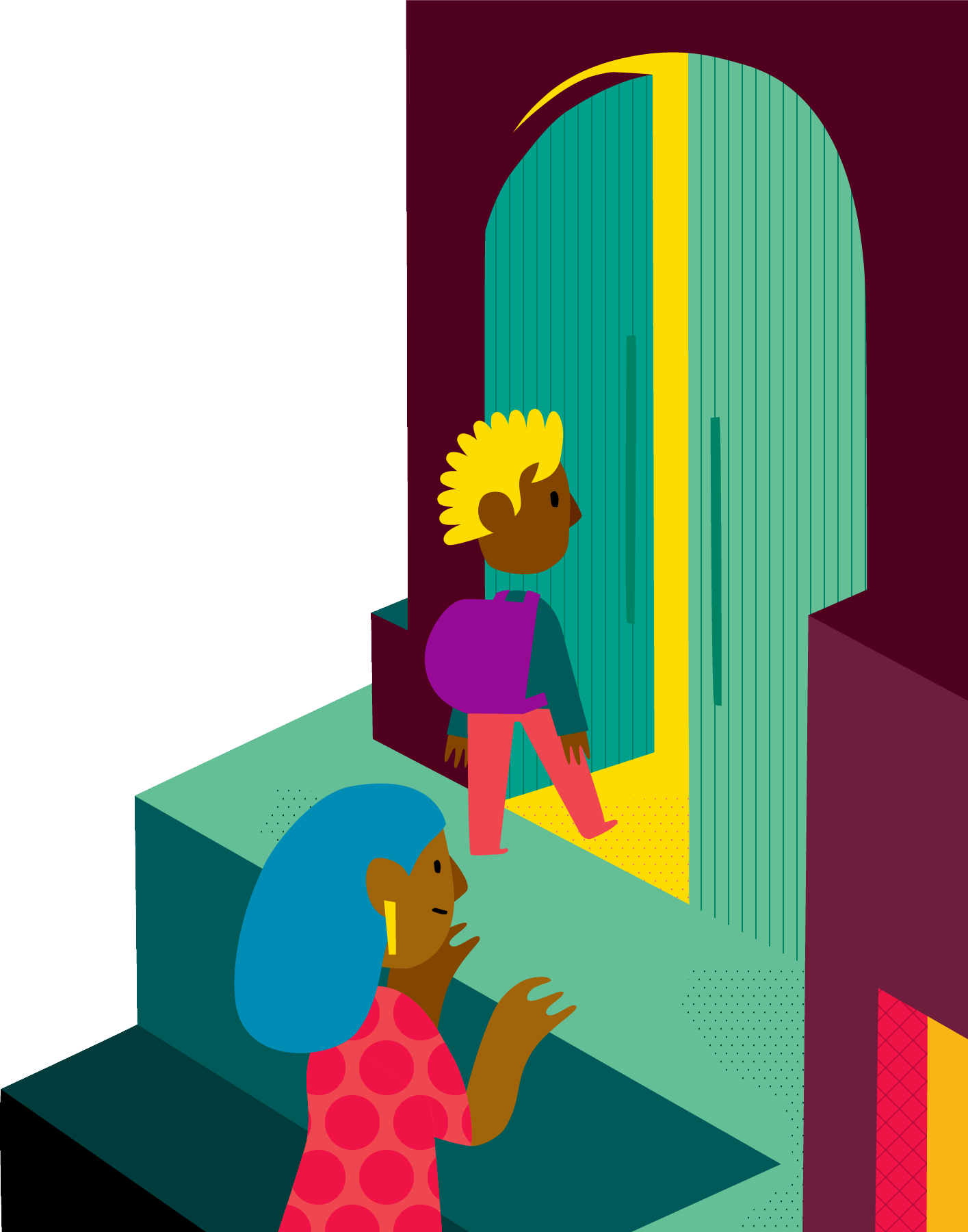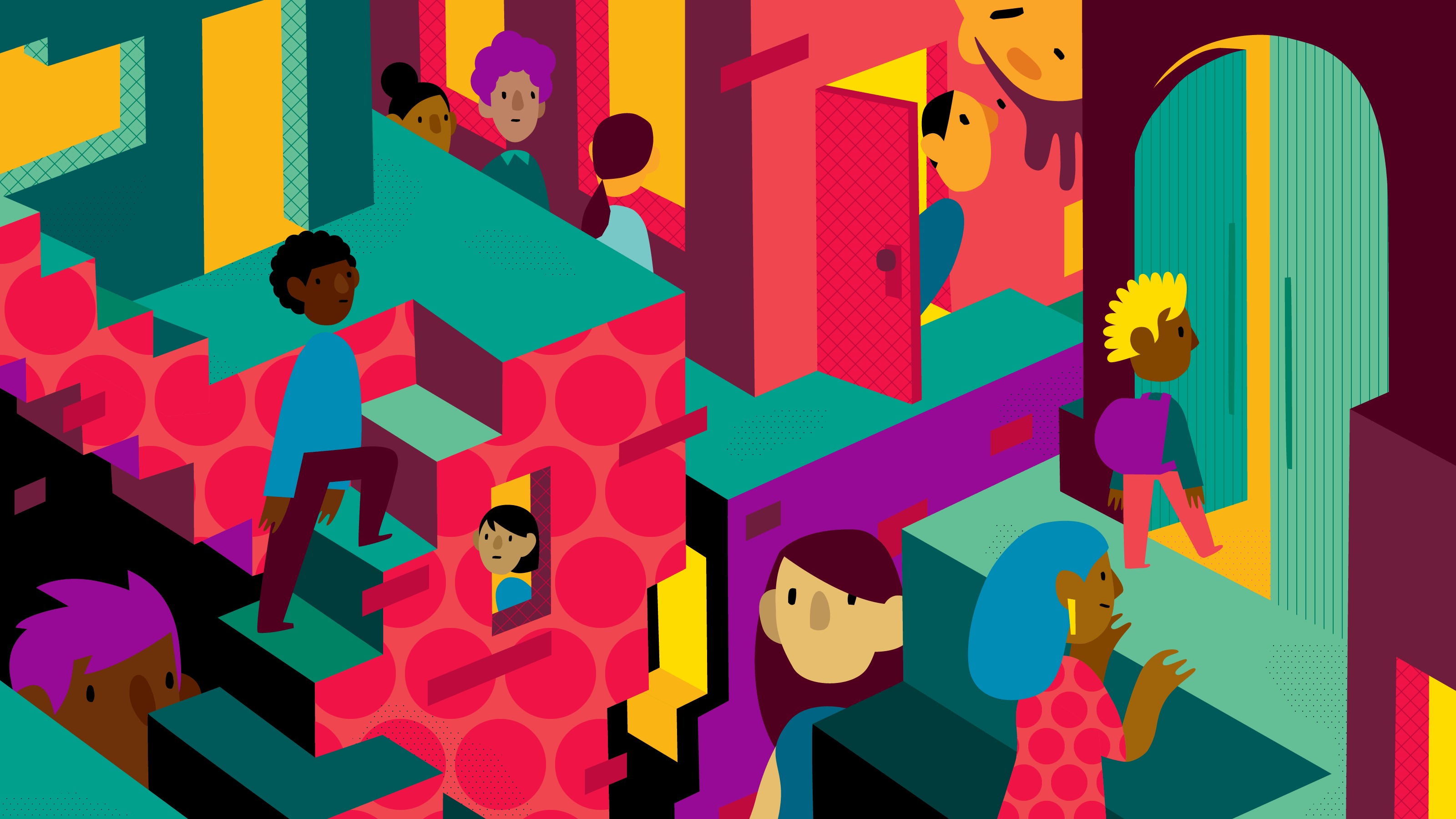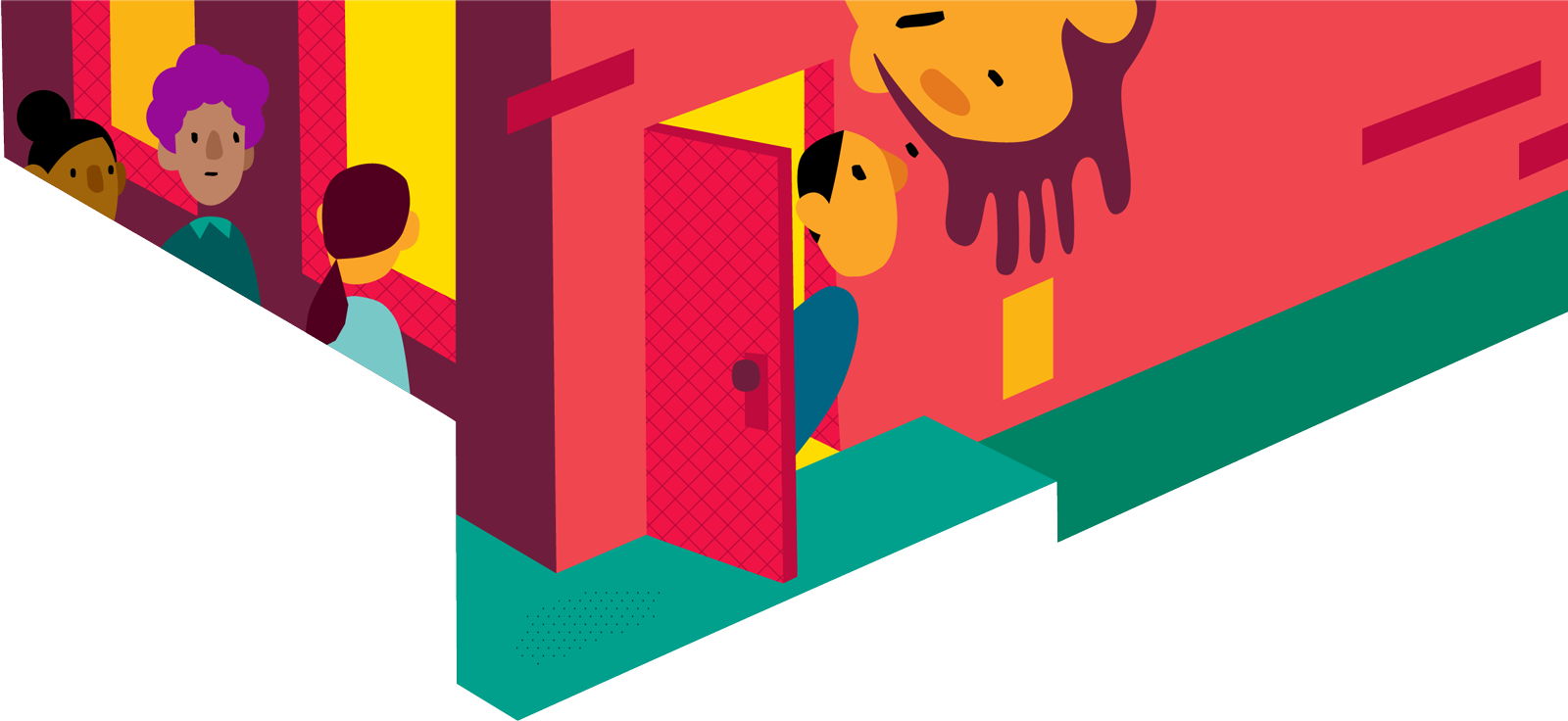Editor’s Note: A crisis on the scale of COVID-19 permeates all aspects of society, for better or worse. We asked 12 Hamilton alumni and professors to share their predictions for what lies ahead.
Journalism
Edvige Jean-François ’90, an international journalist and media consultant, is a former CNN senior producer and White House producer at Associated Press Television News

In the time of coronavirus, even going to the grocery store requires a battle plan: What to wear? When to go? How to safely retreat? Fear, confusion, and upheaval have led to a hunger for news. In March, news consumption globally rose 36 percent, according to one report.
Journalists are accustomed to reporting in extraordinary times, but COVID-19 is a singular moment in our lifetime. We have seen the virus batter our hospitals, ravage our nursing homes, and lay bare racial disparities long ignored. There are countless important stories to tell, as the industry faces job losses, financial pressures, and increased hostilities, including by the president who disparages the media and the First Amendment.
The killing of George Floyd has led to a seismic shift in America — will the reckoning lead to meaningful and lasting reforms? It is just one of the big questions that will be before us. Journalists are part of the transformation America is undergoing; the industry will also need to address the lack of diversity in its ranks.
When this is over, I hope we do not forget those who were invisible before COVID-19, those with sweat, tears, and backbreak in this pandemic. At the height of the coronavirus, it was de rigueur to pause and clap for our frontline workers at evening time, as a “thank you.” I hope after the pandemic, somewhere in the world, people will still gather on any given evening to remember them and clap. How wonderful, if it makes news.
Economy & Markets
Richard Bernstein ’80, CEO of the investment management firm Richard Bernstein Advisors LLC
Many say the economy after COVID-19 will be different, but few forecasters suggest what the changes might be. The U.S. and global economies were already starting to change before coronavirus, and the pandemic will likely exacerbate and accelerate those changes. The biggest change could be the end of globalization. Globalization has historically resembled an accordion: expanding and contracting through time. The accordion has been expanding over the past several decades, but it is starting to contract. It’s popular to blame this contraction on President Trump, and his policies and verbiage have certainly contributed to the contraction, but nationalistic tendencies are growing in many countries. In fact, finance ministers from the world’s 20 largest economies jointly suggested that globalization may be a growing risk to their countries’ sovereignty.
Globalization had both positive and negative effects on the U.S. economy. On the positive side, increased levels of competition kept prices under check, and inflation hasn’t been a meaningful concern in the U.S. for many years. Although nominal wage gains have been rather paltry for some workers, consumers’ purchasing power increased significantly. On the negative side, the U.S. lost jobs from the combination of a globally increasing labor pool and the U.S.’s failure to invest and improve its infrastructure.
If globalization reverses, the biggest change to the U.S. economy could be higher inflation. Disrupting the global flow of goods and services reduces competition, the U.S. does not have a globally competitive infrastructure, and wages will likely rise as labor availability decreases. A secular multi-year period of higher-than-expected inflation would be a meaningful change for the U.S. economy. Global political winds blowing as they are, one should consider how such a change might alter one’s business, one’s investment portfolio, and one’s overall lifestyle.
Education
Christie Bell Vilsack K’72, editor/journalist, former librarian, and teacher who, as first lady of Iowa, focused on education and literacy issues

For eight years, Alberto Carvalho, Miami-Dade Superintendent of Schools, led an effort to invest in preparing for the worst. He trained teachers and educated parents and his community about distance learning. They invested in technology. They were ready when COVID-19 closed their schools. Students and teachers made a seamless transition. Carvalho built resilience into his system. Now, he says, our country can’t go back. Parents have had a hand at teaching. They’ve had a window into their children’s classrooms. Educators have “leaned in.” They’ve innovated. My question is, “How do we continue adapting?”
I face this resilience question as a college board member, as a grandmother, as a classroom volunteer, and as an adviser to the chancellor of Colorado State University involving K-12 programming for Denver’s new National Western Center.
We know in-person learning is best, but how do we continue to offer stellar education under any circumstances to every student? If we capture what worked and what didn’t for educators, parents, and kids over the past three months, we’ll have a wealth of information to direct us. Each community will determine what works locally. Sharing will help decision-makers decide where to focus resources. Leader communities like Miami-Dade can point the way.
Small colleges in rural places will provide safe, personalized education in person and online. Small community schools might choose a hybrid model — keeping some kids home with parents, while others with greater needs may attend in person where they’ll benefit from teacher attention. With help from technology, CSU will create virtual STEM experiences for K-12 students who may have to wait to visit their new water, food, and health buildings.
This pandemic will push us to challenge the status quo and find better ways to teach and learn.
Race Relations
Celeste Day Moore, assistant professor of history
The COVID-19 pandemic has provoked a profound reckoning with the failure of the American state to protect people’s health. While this fact of American life is newly resonant for some, it’s important to underscore that African Americans have long recognized and resisted the state’s continued defense of private property at the expense of Black lives: in the abandonment of Reconstruction, the federal government’s role in institutionalizing residential segregation, the massive expansion of the carceral state, or the dismantling of the Voting Rights Act in 2013. The current crisis has deepened these inequalities and further imperiled those who were already marginalized in terms of employment, health, housing, and participation in civil society.
Looking forward (but still thinking historically), I think it’s possible that this expanding precarity and the breakdown of state capacity will deepen the racist resentment in the United States and beyond. However, this moment could also more clearly show that our current economic system fundamentally depends on racial inequality, a phenomenon that scholars have termed racial capitalism.
As people make sense of these linkages, I think it’s possible that we will see ever more expanding modes of protest and rebellion on a global scale. In this regard, I see direct links to the rich intellectual and political traditions that have defined African-American history, and the work of people like Ida B. Wells, Claudia Jones, Ella Baker, Robert Williams, the Combahee River Collective, and Angela Davis, whose “freedom dreams” (to borrow Robin D.G. Kelley’s phrasing) have sustained Black life and might likewise show a path forward.
For more on this history, I would point readers to the work of Associate Professor of Africana Studies Nigel Westmaas and Erik McDuffie ’92, now associate professor in the Department of African American Studies at the University of Illinois at Urbana-Champaign.

Theatre
Richard Nelson ’72, Tony Award-winning playwright
The theatre will survive, but this pandemic will have taken a deep toll. Theatre means live actors and live audiences in the same room at the same time. No social distancing here. So we will be one of the last businesses to reopen, and even then will people want to sit close together, for hours at a time? What happens with the first cough?
Few non-profit theatres have serious or healthy endowments; a number will undoubtedly close and so less work for theatre artists. Getting back to where we were will take a long time. That’s, of course, if we choose to go back to where we were.
A friend of mine in the foundation world believes what could happen is like after a forest fire; with the heavy underbrush burned away, new shoots are now possible. Perhaps there will be something like that and new ideas or new types of theatres, perhaps those less tied to bricks and mortar and set seasons and subscriptions, will emerge as these shoots.
Every 50 years or so for the last 100 years, the American theatre has reimagined itself, usually as a reaction to a stultifying commercial theatre. Around 1910, a Little Theater Movement sprang up, from which emerged American’s first great playwright, Eugene O’Neill. Fifty years later, the American non-profit theatre erupted bringing professional permanent theatres to much of the country for the first time. Now 50 years later, and in the wake of this pandemic, are we about to witness new efforts at re-imagining what it means to be an American Theatre?
Politics
Phil Klinkner, the James S. Sherman Memorial Professor of Political Science and professor of government; director, Washington, D.C., Program
Many Americans believed that the pandemic might serve to unite us. They hoped that a shared sense of sacrifice and empathy, much like that seen during World War II or natural disasters, would cause Americans to overcome our growing social and partisan rifts. Instead of the pandemic shaping how we view our politics, our politics has shaped how we view the pandemic. Partisan blinders led many to ignore science and common sense in favor of quackery and conspiracy theories. Instead of focusing on keeping people healthy and financially secure, many of our leaders saw the pandemic as just another opportunity to distract and divide Americans for their own political advantage. In addition, America’s governing institutions at the federal, state, and local levels have failed, alone among advanced industrialized democracies, to perform the basic functions of providing for the well-being of the population. As a result, the burden of the pandemic has fallen disproportionately on the poorest and most vulnerable among us. The result is 143,000 (so far) dead Americans, a staggering economy, and even more divisiveness and inequality.
For many years whenever I’ve spoken about the state of American politics, someone always asks me, “When will it get better? When will America start coming together, rather than apart?” The sad fact is that there is no miracle cure. There is no leader who can use his or her eloquence to move us to a higher purpose. America is irrevocably divided between competing political and social visions.
At another moment of great division, Abraham Lincoln warned, “A house divided against itself cannot stand. ... It will become all one thing or all the other.” Today, Americans must again choose what our house shall be.
Technology
Dan Nye ’88, managing director, LBF Investments/Foundation; former CEO, LinkedIn; former president and CEO, Rocket Lawyer

The coronavirus lockdowns accelerated the pace of change as individuals and organizations turned to the internet to socialize, collaborate, create, publish, transact, be entertained, visit their doctors, and do so much more. The question we now face is whether these changes will be long-lasting, or will we return to the old-normal after the virus is behind us. Undoubtedly, when it is safe to do so, we will fill classrooms, religious facilities, auditoriums, concert halls, stadiums, theaters, galleries, and restaurants. We will even shake hands, hug, touch, and kiss again. But, it will not be the same. Societal norms, government regulations, individual choice, and organizational restructurings will create a new-normal. As companies encourage employees to work-from-home and individuals embrace telemedicine, online grocery delivery, and many other services enabled by technology, society will clearly be different from what it was before the lockdowns.
While these changes may have negative consequences such as increased isolation or elimination of certain jobs, they may also deliver meaningful benefits such as reduced stress, closer family bonds, significant cost savings, a reduced carbon footprint, more time for hobbies and exercise, and the creation of new jobs. While technology can deliver extraordinary benefits, it never comes without a cost. To capture the benefits, while minimizing the costs, will still require good personal decision-making and parenting, as well as sound government and organizational policies. That will never change.
Environment
Dan Becker ’77, director of the Safe Climate Transport Campaign at the Center for Biological Diversity
COVID-19 is changing our environment and peoples’ attitudes toward it. We’ve learned that air pollution worsens the virus’ death rate, that people of color are at greater risk from the disease. We’ve confirmed that when we turn off polluting cars, factories, and power plants, air quality improves.
Science matters. Americans need to pay more attention to scientists’ warnings about climate change, just as many have followed medical advice to shelter in place, social distance, and wear masks. We must demand more government action to protect us from carbon pollution that exacerbates droughts, floods, heat waves, and the spread of infectious disease vectors. The pandemic has demonstrated the necessity that governments at all levels act to protect their people. Unfortunately, our federal government fell down on the job.
The pandemic shows we’re all in this together. It is striking that despite overwhelming attention focused on the outbreak, people have risen up to rally together against the infliction of police violence on African Americans. Young people of all races have turned out to protest, demonstrating that with the disease of racism, like the virus, there is no place for American exceptionalism.
I find hope for the future in the grandchildren who wave through windows to cheer their relatives without infecting them and in the resilience of young protesters who demand an end to our nation’s racism. Young people will be the most affected by the climate crisis and they know it. We need to follow their lead to secure the clean cars and clean energy that must be our future if we are to leave a safe climate to our children and their children.
Religion
Jaime Kucinskas, assistant professor of sociology

Prior to the COVID-19 pandemic, the religious landscape in the United States had already been undergoing considerable changes. Mainstream Christianity has been on the decline. Increasing Americans, and especially young people, identify as spiritual but not religious and/or religiously non-affiliated atheists, agnostics or “nones” (Pew Research Center 2019). The COVID-19 epidemic will likely exacerbate these changes, making it unlikely that some older people, who typically attend church, continue to do so. Instead, many regular churchgoers are already turning to watch services online or on TV (Pew Research Center 2020). Such changes will inevitably lead some people to realize they can practice their religion in other ways, through small virtual or in-person groups or simply by watching services virtually. This will most likely deepen fiscal deficits for many Protestant and Catholic congregations, which have been experiencing diminishing contributions from members for decades. Some churches may go under. As churches have long been a social cornerstone of American society, and important source of community support and aid, it is my hope that as the religious and spiritual landscape reconfigures in a society more reliant on digital technologies and focused on individual spiritual development, that we do not forget the importance of collectively working to better our communities and sharing resources with those in need.
Sources:
- “In U.S., Decline of Christianity Continues at Rapid Pace” Pew Research Center, October 17, 2019
- “Most Americans Say Coronavirus Outbreak Has Impacted Their Lives” Pew Research Center, March 30, 2020
Sports
Mason Ashe ’85, a sports attorney and NBA- and FIBA-certified sports agent and adjunct professor who teaches sports law at The Wharton School of the University of Pennsylvania and the Howard University School of Law
The coronavirus may have changed where and how sports competitions are played, packaged, and consumed forever. The business of sports is often studied in three segments: amateur, Olympic, and professional. This past March, all three of these distinct ecosystems were forced to cease conducting business as usual and pay attention to what the scientific evidence about the pandemic informed us. This is true in the United States, as well as across the globe.
When the NCAA cancelled basketball’s March Madness, fans of amateur sports knew something serious was going on that should not be ignored. It was hard to believe the Olympics would be postponed, but it had to happen given the various levels of success countries around the world experienced with containing COVID-19. The professional leagues globally had millions of dollars at stake when they were forced to cancel play or postponed seasons due to their players and executives testing positive.
The future of sports will follow science. Until the coronavirus is defeated or there is an effective vaccine, amateur sports organizations will host competitions when and where the science allows. Youth travel teams will wait until it is safe to gather, and then develop protocols to keep players, families, coaches, and organizers safe. Most collegiate athletes will wait, but some elite athletes with potential professional careers in the balance may seek alternative places to play where the coronavirus is better managed; even if that is in another country. Professional leagues will create “bubble zones” to resume competitions and deliver a return on investment to stakeholders; even without spectators.
WORK
Aron Ain ’79, CEO of Kronos Inc. and Ultimate Software, two companies (merged on April 1, 2020) known for their award-winning workplace cultures. Ain is also author of WorkInspired: How to Build an Organization Where Everyone Loves to Work.

When I hear predictions for how the pandemic will change work forever, I think, “How do you know that!?” While it has felt like a lifetime, 90-120 days of work upheaval is not enough to draw conclusions about the future of virtual work, online learning, workplace layouts, or anything else. The resilience and creativity shown by organizations and their employees under intense pressure has been remarkable. Yet the tunnel we are traveling through today won’t be completely reflective of what to expect on the other side.
There are opportunities, of course, and three things are clear:
Trust is the magic glue
Employees who feel trusted are more engaged and perform better. COVID-19 has been an eye opener for organizations yet to take the leap into remote work or empowering workers in new and independent ways. We can now move more comfortably into a world of what employees do, not where or when they do it.
Support systems are critical
Childcare is integral to our economic success. The availability of schools, daycares, and camps have greatly impacted reopening plans. Eldercare and access to reliable transportation are also crucial. Organizations and societies must work to create and protect the support systems vital to keeping the economic engine running.
Care and compassion must redefine leadership
I have long believed that people managers have the biggest impact on overall success. Now I’m doubling down. Thoughtful listeners, over communicators, and leaders who extend trust and honesty have put their organizations in position to not just survive, but thrive. Those who have built a culture of caring have a distinct advantage in hiring and retention as the economy begins to thrive again.
Diplomacy
Regina Joseph ’87, superforecaster and founder of Sibylink & Cofounder of Pytho LLC [Twitter: @Superforecastr]
Assessing the future of America’s post-COVID-19 relationship with the rest of the world begins — as all good forecasting does — with looking at historical priors: in 1949, the North Atlantic treaty was signed. It ushered in American primacy and history’s most stable international alliance. Now to our present: in the three years leading to the treaty’s 70th anniversary, America’s reputation and image have altered significantly in the eyes of both its allies and its adversaries. With coronavirus now gripping the globe, America is further reduced to a status reserved for unstable and unreliable nations. Blocked from European borders, Americans are shunned for insufficient precautionary competence by the countries the North Atlantic Treaty aimed to safeguard.
Extrapolating from the present into the post-COVID future, even conditional to a change in governance, American authority and prestige on the world stage are not assured. At home, the hollowing of the U.S. Department of State will require both restoring a seasoned and diverse diplomatic corps and refashioning a body known for being “pale, male, and Yale.” Abroad, absence of American leadership has created a vacuum into which the old monsters of Europe — fascism, racism, ethnic conflict — have crept. The stability of both NATO and the EU are in question. As China, India, and Russia seek to preserve dominance in their near-abroad with force if necessary, Latin America and Africa face the traps of corruption and resource capitalism.
The post-COVID landscape the United States faces internationally necessitates ingenuity, new models, and resolve to repair. And above all, time. Adjusting overly rosy predictions to the reality of progress’ slow, incremental change will distinguish the most accurate of our post-COVID forecasts.

